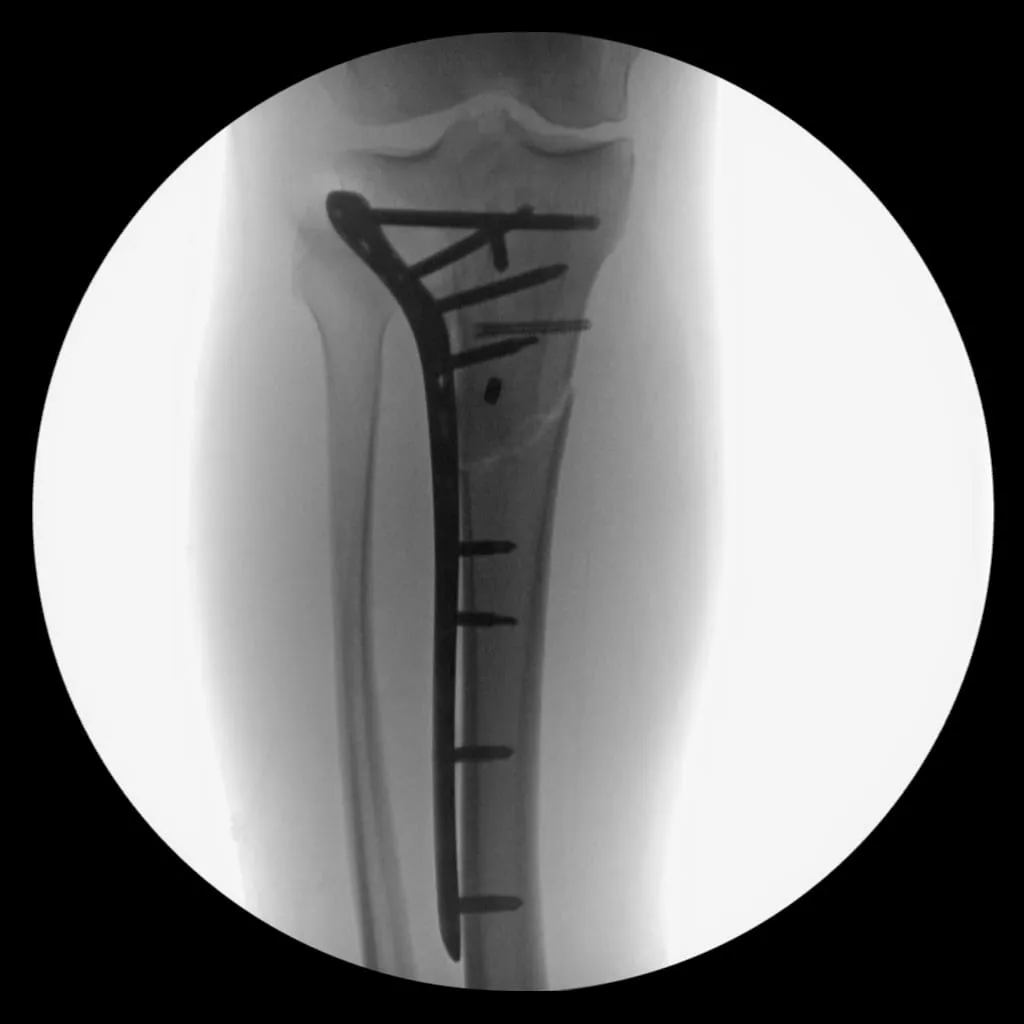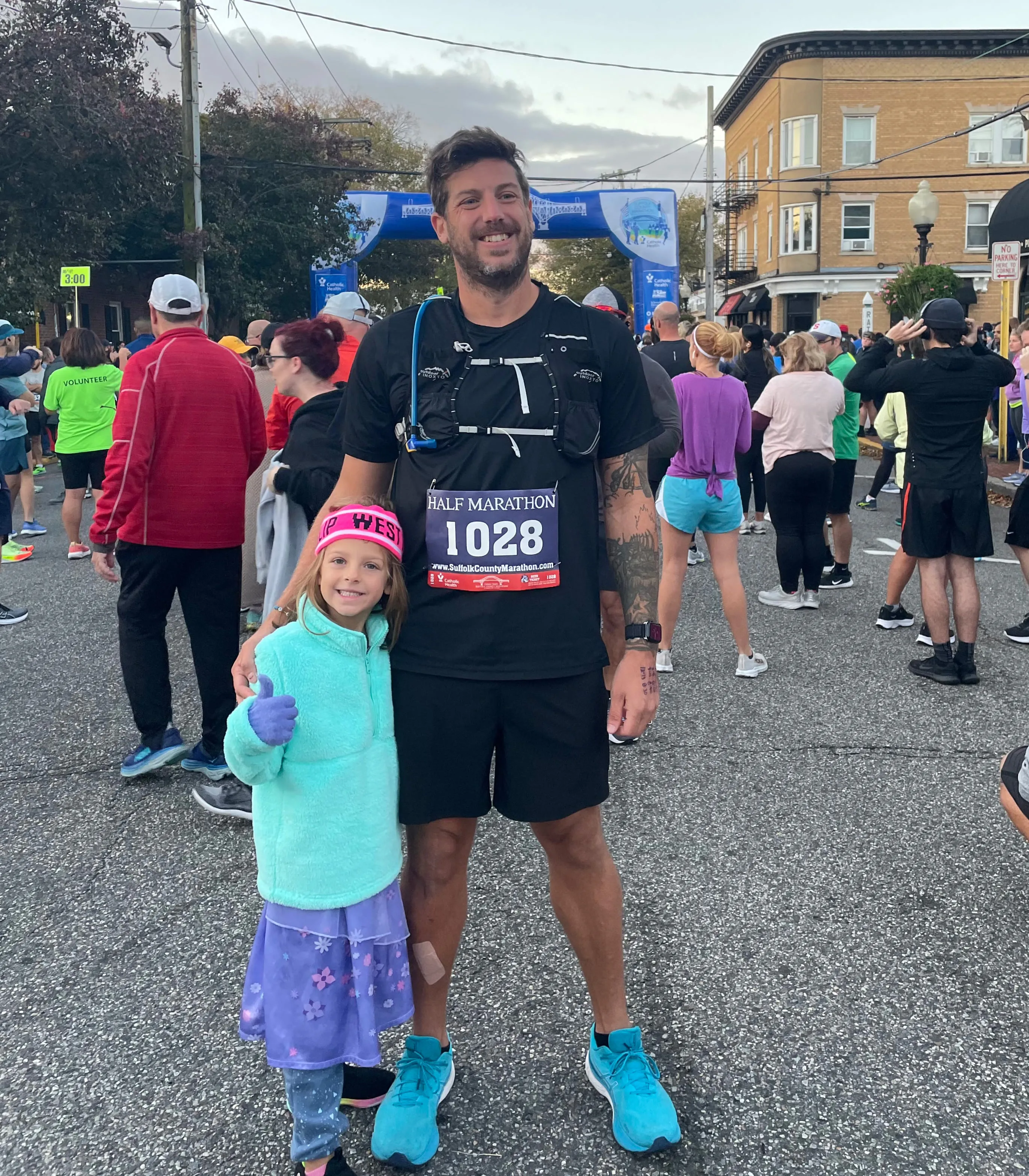Running a Half Marathon 10 Months After Breaking My Leg
🗓️ • ⏱️ 13 min read

🗓️ • ⏱️ 13 min read
This post is a significant departure from what I usually write about here. However, I think it’s a story worth sharing. Also, today marks the one-year anniversary since I broke my leg, so it feels fitting. As the title states, I broke my leg running and then, less than 10 months later, completed a half marathon race in under 2 hours.
At the time of the race, I was 37 years old. I played sports in high school and kept fit by running. However, I never ran more than 6-7 miles at a time. In 2014, I blew my knee out while surfing on my honeymoon in Fiji. I had to undergo major knee surgeries in 2014 and 2019 and a minor surgery in 2015. The surgeries in 2014 and 2019 left me on crutches and unable to bear weight on my right leg for months, causing severe muscle atrophy each time.
After years of starts and stops, in June 2022, I finally regained enough mental and physical strength to start running again. I ran two 5k races in the fall of 2022, achieving times of 22:26 (7:13/mile) and 21:36 (6:57/mile).
On January 1st, 2023, the weather here in New York was unseasonably warm. It was about 55°F (12°C), and the sun was shining. I figured I’d take advantage of the warmth to go out for a run. About a mile into my 5k run, I felt an odd pain in my leg. Then, before I knew it, I felt and heard a large snap, like a tree branch breaking. My right tibia had broken in two, and I went down to the ground hard. Unluckily for me, I didn’t have my phone on me to call anyone for help. Luckily, some people saw/heard me wincing for help on the street in front of their house and came out to help. They called 911, and my wife and I spent the rest of New Year’s Day in the emergency room waiting to find out what the damage was and what was next for me.
In the days following, Every doctor I spoke to said it was a freak thing, but it was related to my previous injuries and surgeries. I had also gone ice skating for the first time in 10 years a couple of days before this run, and I think that was the catalyst for the fracture.
Nine days later, I underwent surgery to install additional hardware to support the fracture. Here is the x-ray from my first post-op appointment.

This marked the third time in eight years that I found myself on crutches and unable to put weight through my leg for 2.5 months. I had to undergo physical therapy three times a week to regain the ability to walk. Four months after surgery, at the end of April, I took my first running steps on a treadmill at physical therapy.
By June 2023, I felt confident enough to go for short 1-2 mile jogs on the local track and eventually returned to running on the street a few weeks later. However, I struggled to make progress because I was pushing myself too hard, and my body wasn’t ready for that.
After researching and lurking on Reddit, I discovered the book 80/20 Running by Matt Fitzgerald, which completely changed my perspective on running. I purchased a half marathon run plan from 8020endurance.com and set a goal to train for and complete a sub-2-hour half marathon in less than four months.
Running “slow” was never my thing, but after calculating my heart rate zones and trying a week of maintaining my heart rate in Zone 2, I was convinced of the benefits and committed to the plan. I used the purchased run plan and built my own schedule, adhering to the 80/20 split. Before my injuries, my “slow” pace was approximately 8:30 per mile (5:17 per km), and my 5k and 10k paces were in the low 7:00 per mile (4:21 per km) range. I set an initial goal of running sub-2 hours (9:10 per mile or 5:42 per km), but I was open to adjusting this goal based on my progress.
I tracked all my runs and progress in a spreadsheet, which you can view here.
In addition to running, I worked out with a personal trainer, doing HIIT-style workouts for 45 minutes twice a week. Most of those workouts included a warmup run, which I incorporated into my weekly run plans and are noted as “Workout Warmup” in the spreadsheet.
Here are some key statistics from my 16-week training, also available in the spreadsheet.
| Month | Runs | Miles | Avg Distance | Total Time | Avg Pace |
|---|---|---|---|---|---|
| July | 21 | 70.58 | 3.36 | 12:15:35 | 10:25/mi (6:28/km) |
| August | 25 | 101.69 | 4.07 | 15:55:03 | 9:24/mi (5:50/km) |
| September | 19 | 91.4 | 4.81 | 13:43:28 | 9:01/mi (5:36/km) |
| October | 15 | 95.25 | 6.35 | 14:14:54 | 8:59/mi (5:35/km) |
| Total | 80 | 358.92 | 4.49 | 56:09:00 | 9:23/mi (5:50/km) |
During the 16-week training period, I had to take a break only once, during week 13, due to hip/pelvis issues. Fearing it might jeopardize my race, I stopped workouts with the trainer, returned to physical therapy twice a week, and scaled back my running. After a week of reduced physical activity, I cautiously resumed running with only minor lingering hip problems.
Excluding the race, I maintained an almost perfect 80/20 split throughout the 16 weeks of training.
| Duration | Percentage | Miles | |
|---|---|---|---|
| Low Intensity Runs | 43:15:36 | 79.8% | 264.76 |
| High Intensity Runs | 10:57:58 | 20.2% | 81.06 |
My longest training runs were 10.67 miles, 12.82 miles, and 12.95 miles, with the last 12.95 two weeks before the race. In the final six weeks, I maintained a pace in the low 9:00 per mile (5:36 per km) range while staying within my Zone 2 heart rate. Aside from the nagging hip issues, I felt prepared and confident about achieving my sub-2-hour goal.
In addition to 80/20 Running, I read a few other books during my training period to keep me motivated and provide me with info/tips along my journey.
I find running super meditative. It’s one of the many reasons I love it. I didn’t listen to music or anything else while training. Running without audio distraction allowed me to clear my mind the best I could or focus on all the possibilities that may happen during the race. Given that most of my training was based on keeping my heart rate in a specific zone, I spent a lot of time trying to keep myself calm. Towards the end of training, I came up with the following mantra. I’d repeat this over and over to myself during both easy and tough runs. It truly helped keep me calm and focused on breathing and the task at hand. I also found it incredibly useful during the later stages of the race.
I am strong.
I am ready.
I can climb over any wall.
Stay hard.
Take souls.
In the week leading up to the race, I ran five days, the longest being 45 minutes on Tuesday. All other runs were 30 minutes or less.
Throughout my training, I progressively improved my diet, focusing on whole foods and eliminating unnecessary eating, although I wasn’t too strict about it. I don’t drink much alcohol to begin with, but there were a few occasions of drinking. Besides those times, my beverage intake was limited to water, coffee, and occasional almond milk with cereal. For race week, I maintained a clean diet, including whole grain cereal, fruit, and almond milk if I was eating breakfast. Lunches consisted of tuna salad on whole wheat bread or hard-boiled eggs, while dinner options included brown rice, potatoes, salmon, chicken breast, shrimp, vegetables, and salads. Cooking is something I enjoy, so managing my diet was relatively easy.
The night before the race, I made one of my favorite dishes: linguini and clams with grilled asparagus.
Although I was eating well, anxiety and nerves affected my sleep throughout the week. Miraculously, I managed to get decent sleep on the two nights leading up to the race.
I drove the course two days before the race, visualizing running it and considering how I’d feel at different mile markers.
On the morning of the race, I woke up at 5:45 am. The race started at 7:30 am, and I live less than 10 minutes from the starting line, so an hour and forty-five minutes was sufficient to complete my pre-race routine. I made coffee, hydrated, used the bathroom, stretched, and watched David Goggins videos for motivation. At 7 am, my wife and daughter hopped in the car, and we headed to the starting line. While waiting for the race to begin, I warmed up my legs with light jogging and active stretching.

Before the race, at the start line with my daughter
| Name | Suffolk County Half Marathon |
|---|---|
| Date | October 22nd, 2023 |
| Distance | 13.1 miles (21 km) |
| Location | Babylon/West Islip/Brightwaters, Long Island, New York |
| Weather | Some Clouds, 50°F (10°C), Wind 15-25 mph (25-40 kph) |
| Official Time | 1:55:26 (8:48/mile / 5:28/km) |
At some point during my summer training, I purchased a cheap running vest from Amazon and used it to carry a Camelbak bladder I’d had for a while. I decided to run the race with the vest so I could drink as needed and not rely on the water stations. I only filled the bladder with about 1.5 liters of water and still had some left when I finished, but I was glad I had it, just in case.
All three races, the full marathon, half marathon, and 10k, started simultaneously. Initially, I found myself amid the pack, crossing the start line about a minute after the gun went off. I hadn’t anticipated how crowded it would be, and I started to worry as people surrounded me. My initial pace was around 11:00 per mile (6:50 per km) for the first few hundred meters. I started making moves to find some space, and about half a mile in, I settled into a comfortable pace. My adrenaline was pumping, and I felt great. I finished the first mile right on target. However, over the next 8 miles, I veered away from my original plan, running a quicker pace of around 8:35 per mile (5:20 per km) instead of my target of 8:46 per mile (5:27 per km).
The course was mostly flat, except for a gradual incline/decline of about 50 feet (15 meters) over the Robert Moses Bridge. We crossed the bridge twice, as there was a turnaround about 2 miles past it. I felt good about my faster pace until around mile 10 when we got on the bridge again over open water, and the 15-25 mph wind was blowing right into us. The climb to the top of the bridge felt significantly more challenging than the first time, and my pace started to suffer. The top of the bridge was around the 11-mile marker, and I knew I only had the downhill section with about 2 miles to go. I had to dig deep to push through and keep moving forward. At this point, I didn’t care how slow I was; I was determined to finish.

Robert Moses Bridge. Copyright: © Joseph Nuzzo, Shutter Speak llc.
As I approached the finish line, I pushed myself to increase my pace as much as possible. Unfortunately, the finish line only became visible in the last 60 meters, so I felt like I could have kicked earlier had I seen it sooner. Nevertheless, with the finish line in sight, I passed the three runners ahead of me and crossed the finish line at a pace of 7:11 per mile (4:28 per km).
I had an ideal plan of running negative splits but also expected that I’d go with the flow of how I was feeling. As you can see below, I didn’t achieve negative splits but mainly held even splits until the last few miles.
| Mile | Race Pace | Target Pace |
|---|---|---|
| 1 | 9:02 (5:37/km) | 9:00 (5:36/km) |
| 2 | 8:34 (5:19/km) | 9:00 (5:36/km) |
| 3 | 8:40 (5:23/km) | 8:50 (5:29/km) |
| 4 | 8:39 (5:22/km) | 8:50 (5:29/km) |
| 5 | 8:39 (5:22/km) | 8:50 (5:29/km) |
| 6 | 8:36 (5:21/km) | 8:50 (5:29/km) |
| 7 | 8:21 (5:11/km) | 8:50 (5:29/km) |
| 8 | 8:25 (5:14/km) | 8:50 (5:29/km) |
| 9 | 8:32 (5:18/km) | 8:40 (5:23/km) |
| 10 | 8:37 (5:21/km) | 8:40 (5:23/km) |
| 11 | 9:13 (5:44/km) | 8:40 (5:23/km) |
| 12 | 9:05 (5:39/km) | 8:30 (5:17/km) |
| 13 | 9:42 (6:02/km) | 8:30 (5:17/km) |
| 0.15 | 8:44 (5:26/km) | 8:00 (4:58/km) |
Crossing the finish line felt surreal. Over the past nine months, I had faced numerous challenges, and for the last four months, I had been laser-focused on reaching this exact moment. I had pushed hard in the final miles, and it was all a blur. I was handed a medal and directed to the post-race tent, where I grabbed a bagel and a cup of Gatorade. I wasn’t particularly hungry or thirsty, but I knew my body needed the carbs and calories.
I found a place to sit and collect my thoughts for a few minutes. My wife and daughter found me and gave me hugs. My wife grabbed me a cold beer, which I was looking forward to. We went home, I showered, enjoyed a breakfast sandwich, and spent most of the day in bed watching football and the F1 race.

There were no lingering effects on my body, but I still went to physical therapy the day after the race for recovery. I took four days off from any physical activity but returned to running with a short, slow, 25-minute run on the Friday after the race.
Other than a 5k race I ran two weeks after the half marathon, I don’t plan on racing again until at least spring 2024. I will continue running regularly and will use the runs from the half marathon training plan as a foundation for structuring my weeks.
I was concerned that completing this half marathon might spark an interest in a full marathon, but I’m content with sticking to the half. Maybe I’ll run it again next year.
Coming full circle today, on the first anniversary of breaking my leg, I went and ran the route I intended to run a year ago. It looks like I have a new New Year’s Day tradition.
Since starting to run again in June, I ran 138 times, covering 500.7 miles over 76 hours and 23 minutes. Those stats may not be impressive to seasoned runners, but that is the most I’ve ever run in a year, and I did it in just over 6 months.
I’m incredibly thankful to be running again and achieving new goals. Throughout my training, I never took for granted how fortunate I was to be able to run again. My first surgeon, before telling me there was nothing else he could do for me, also told me I’d most likely never run again. For too long, I truly believed that. So, even on the tough days, I find so much comfort in the gratitude I have that I’m out running.
Comments